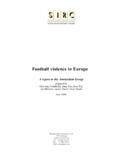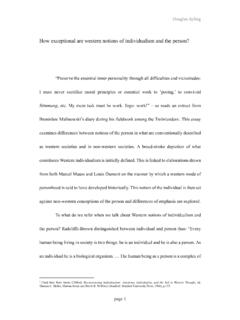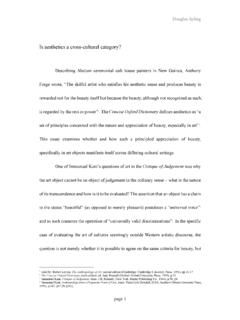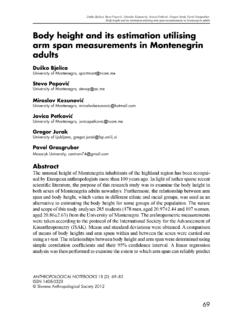Transcription of Food and Eating An Anthropological Perspective
1 Food and Eating : An AnthropologicalPerspectiveBy Robin FoxThe Myth of NutritionWe have to eat; we like to eat; Eating makes us feel good; it is more importantthan sex. To ensure genetic survival the sex urge need only be satisfied a fewtimes in a lifetime; the hunger urge must be satisfied every is also a profoundly social urge. Food is almost always shared; people eattogether; mealtimes are events when the whole family or settlement or villagecomes together. Food is also an occasion for sharing, for distributing andgiving, for the expression of altruism, whether from parents to children,children to in-laws, or anyone to visitors and strangers. Food is the mostimportant thing a mother gives a child; it is the substance of her own body,and in most parts of the world mother s milk is still the only safe food forinfants. Thus food becomes not just a symbol of, but the reality of, love animals eat, but we are the only animal that cooks. So cooking becomesmore than a necessity, it is the symbol of our humanity, what marks us offfrom the rest of nature.
2 And because Eating is almost always a group event (asopposed to sex), food becomes a focus of symbolic activity about sociality andour place in our body needs fuel. But this need could be served by a rough diet of smallgame, roots, and berries, as it was for several million years. Or, even moreextreme, pills could be synthesized to give us all we need (except bulk). Butour tastes have never been governed solely by nutrition. Modernnutritionists chanted the litany of the four food types (vegetables, grains,dairy products, meats) from which we were supposed to take more or lessequal amounts daily. But dairy and domestic meat fats are now consideredharmful, and a new food pyramid equally misleading is being fact, nutrition plays only a small part in our food choices. Adele Davis,whose bossy opinions on food were to a whole generation as authoritative asDr. Spock s on childrearing (she recommended a diet of liver and yogurt),held that European history was determined by food habits.
3 The French atewhite bread and drank wine and strong coffee, she said, and this was about asnutritionally disastrous as possible; the Germans, on the other hand, ate darkbread and drank beer both nutritionally sound. Was it any wonder, sheasked, that the Germans kept beating the French? But even if both nationswere to accept this interesting hypothesis as sound, do we believe they wouldchange their food preferences?|Social Issues Research Centre1 Nor are these preferences solely governed by what is available. All cultures goto considerable lengths to obtain preferred foods, and often ignore valuablefood sources close at hand. The English do not eat horse and dog;Mohammedans refuse pork; Jews have a whole litany of forbidden foods (seeLeviticus); Americans despise offal; Hindus taboo beef and so on. Peoplewill not just eat anything, whatever the circumstances. In fact, omnivorousnessis often treated as a joke. The Chinese are indeed thought by their morefastidious neighbors to eat anything.
4 The Vietnamese used to say that the bestway to get rid of the Americans would be to invite in the Chinese, who wouldsurely find them good to Eat What You AreSince everyone must eat, what we eat becomes a most powerful symbol ofwho we are. To set yourself apart from others by what you will and will noteat is a social barrier almost as powerful as the incest taboo, which tells uswith whom we may or may not have sex. Some cultures equate the twotaboos. Margaret Mead quotes a New Guinea proverb that goes, Your ownmother, your own sister, your own pigs, your own yams which you have piledup, you may not eat. Own food, like related women, is for exchange, for giftgiving, for social generosity, for forging alliances, but not for personalconsumption. The obverse of this is that you identify yourself with others byeating the same things in the same way. To achieve such identification, peoplewill struggle to eat things they loath, and avoid perfectly tasty food that is onthe forbidden list.
5 In the process of social climbing people have to learn to likecaviar, artichokes, snails, and asparagus, and scorn dumplings, fish and chips,and meat and potato pie all more nutritious, but fatally tainted withlower-class are as many kinds of food identification as there are the same in fashion,speech, music, manners and the like. The obvious ones are ethnic, religiousand class identifications. Ethnic food preferences only become identitymarkers in the presence of gustatory foreigners, such as when one goesabroad, or when the foreigners visit the home shores. The insecure will clingdesperately to home food habits: English housewives on the continent evenbreak open tea bags to make a proper cup of tea (the taste is identical).Popular songs attest to the food difficulties of interethnic marriages bangersand mash vs. macaroni. When various ethnic groups are forcibly throwntogether, there is both an intensifying of food identity and a growingmishmash. The American melting pot is almost literally that: the foodpreferences of dozens of nations are put side by side, and there cannot help butbe overlap and mixing.
6 The most startling example is the popularity of theChinese kosher restaurant, and it is not uncommon to find a restaurantadvertising itself as Chinese-Italian-American along with the proud boast All Our Wines Are Chilled. The ubiquitous diner with its vast menuserved twenty-four hours a day is a microcosm of the melting pot, havingGreek salad, Italian pasta, German rye bread, Polish kielbasi, Chinese chowmein, Belgian waffles, French quiche, Hungarian goulash, Irish stew, Jewishgefilte fish, Russian blintzes, English muffins, Austrian pastries, Swiss cheese,Social Issues Research Centre2 Food and Eating : An Anthropological PerspectiveYou Eat What You AreMexican enchiladas, Spanish gazpacho, Canadian bacon, Japanese teriyaki,German sausages, Norwegian herring, Lebanese pita, Nova Scotia salmon andVirginia and Table MannersNot knowing how to eat properly is universally a sign of outsider Eating includes the kind of food used, the way of preparing it, themanner of serving it, and the way of Eating it.
7 The intricacies of the teaceremony are known only to experienced Japanese; social climbers in theWest can be spotted immediately by their inability to master the details ofplace settings; using the wrong fork is an offense as grave as spitting inpublic. Since anyone wishing to integrate himself into a group must eat with it,there is no surer way of marking off those who are in and those out than byfood etiquette. Dipping with hands into a communal dish is de rigeur in somecultures, abhorrent in others. Shovelling food into the mouth with a forkwould be seen as the height of indelicacy by some; the absence of forks as theheight of barbarity by others. Fingers may have been made before forks, butever since Catherine (and Marie) de Medici brought these essential tools fornoodle Eating from northern Italy to France, the perfectly useful finger hasbeen socially out, except for fruit and cheese. It took the elaborate dininghabits of the upper classes to refine the use of multiple forks (as well asknives, spoons, and glasses).
8 The timing of Eating shows up class differences. In the past, as in the novels ofJane Austen, for example, the upper classes breakfasted late (about 10o clock), as befitted their leisure status. (This distinguished them from thelower orders, who eat very early before going off to work.) They had perhapsan informal lunch of cold meats, but the next main meal was dinner, whichwas eaten anywhere between five and seven, depending on the pretensions ofthe family. A light supper might be served before bedtime. The lower orders,meanwhile, would be Eating a light midday meal and then a hearty tea afterthe day s work was done, with again a supper before importance of lunch as a main meal came later from the businesscommunity, and dinner was pushed back into the evening, with supper moreor less abolished. The lower orders continued to make midday dinner and high tea major meals, and since dinner was pushed later for the middleclasses, tea became an institution around four o clock.
9 There is nonutritional sense to the timing of Eating . It could be done differently. The latebreakfast was primarily a sign of status and nothing else; Jane Austen scharacters always had to kill time in some way before breakfasting, and thesewere good hours in which to advance the plot. In France, the enormousmidday meal, with its postprandial siesta, is what the day revolves around. Theentire country comes to a stop and wakes up again between three and order in which foods are eaten, which really does not matter, becomeshighly ritualistic: Soup, fish, poultry, meat, dessert (which echoes the processof evolution) becomes a standard. Sweet should not be eaten before savory,Social Issues Research Centre3 Food and Eating : An Anthropological PerspectiveTables and Table Mannersand rarely (in France never) with. The French eat salad after the main dish, theAmericans rigidly before; the English, to the disgust of both, put it on thesame plate as the (cold) meat. In the East, it is more common to serve all thefood together, often in communal dishes, and allow a wide sampling ofdifferent items.
10 In the more individualistic West, place settings are rigidly setof from each other, and so are courses. The serving of wine with foodbecomes even more rigidly a matter of protocol, and operates to mark offdifferences of status within classes: those who know wine and those who donot. Classes in corporate health in the United States now include sessions on How to Read a Wine Label. The rationale is that without such knowledgecorporate executives may be subject to stress, which would impair foods tend to be shunned by the working classes, but among theupper-middle and upper they become items of prestige. A knowledge offoreign food indicates the eater s urbanity and cosmopolitanism. Untilrecently, being conversant with foreign food was a privilege of those whocould afford to travel, but now the knowledge has been democratized by cheaptravel and television. Julia Child taught the aspiring middle classes how to be French cooks, and now TV abounds with every kind of cooking often find their cooking list to be their most lucrative, andcookbooks of all nations now crowd the bookstore shelves.












